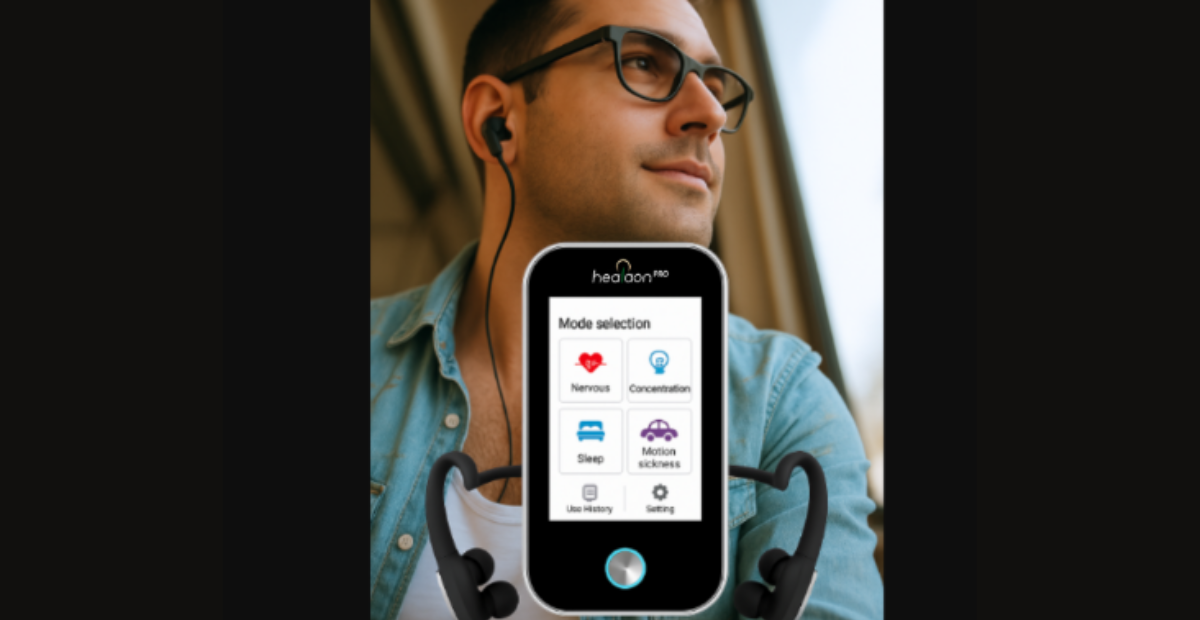Vagus nerve stimulation at home is becoming an increasingly popular approach for those seeking to support their nervous system health, stress management, and overall well-being. With both natural techniques and advanced device-based options available, more people are discovering accessible ways to integrate this therapy into their daily routine.
This article will discuss the science behind vagus nerve stimulation, explore natural practices you can try without equipment, and highlight how modern devices can enhance your results. Whether you’re curious about gentle breathing exercises or innovative stimulators, you’ll find practical insights ahead, so keep reading to discover which methods may suit you best.
Understanding the Vagus Nerve and Its Role in Wellness
The vagus nerve is the longest cranial nerve in the body, connecting the brainstem to multiple organs, including the heart, lungs, and digestive system. It plays an important role in regulating the parasympathetic nervous system, which influences rest, digestion, and recovery processes.
Research has suggested that certain forms of vagus nerve stimulation may have potential benefits in supporting relaxation, reducing stress responses, and possibly influencing inflammation levels. While much of the clinical evidence is based on medical-grade devices used in supervised environments, consumer-level options and natural techniques have gained popularity for at-home exploration.
Natural Approaches to Vagus Nerve Stimulation at Home

Not all forms of vagus nerve stimulation require a device. Some lifestyle practices and natural techniques may activate vagal pathways to varying degrees. Commonly discussed examples include:
-
Deep Breathing Exercises – Slow, diaphragmatic breathing can influence parasympathetic activity, which is closely linked to vagus nerve function.
-
Cold Exposure – Brief, controlled exposure to cold water, such as face immersion, has been noted in some studies to activate vagal responses.
-
Meditation and Mindfulness – Practices that encourage a calm, focused state may enhance parasympathetic activity.
-
Singing or Chanting – Vocal cord vibrations may stimulate certain vagal pathways.
-
Yoga and Gentle Movement – Specific postures and breathing patterns in yoga may have indirect vagus nerve benefits.
While these methods are generally low-risk for most individuals, it’s important to remember that results can vary greatly and that they should be adapted to your comfort and health status.
How At-Home Vagus Nerve Stimulation Devices Work
Consumer-level vagus nerve stimulation devices are typically non-invasive, meaning they deliver mild electrical impulses to targeted nerve areas, often through the ear or neck, without requiring surgery or implanted hardware. These devices aim to mimic certain aspects of clinical vagus nerve stimulation in a more accessible way.
However, the strength, precision, and clinical backing of consumer devices can differ significantly from medically prescribed equipment. Therefore, while some users report positive experiences, the potential effects, limitations, and long-term outcomes require further study. Professional advice can help determine whether an at-home device may be appropriate for your individual health needs.
Product Spotlight: Neurive Healaon Pro Vagus Nerve Stimulator

The Neurive Healaon Pro Vagus Nerve Stimulator is designed as a non-invasive, consumer-oriented option for those exploring gentle vagus nerve stimulation at home. It offers features intended to make sessions more comfortable and accessible, while still emphasizing that any wellness tool should be approached with care and professional guidance.
Key Features
-
Non-invasive design – Avoids surgical procedures by delivering stimulation through external application.
-
Adjustable intensity settings – Allows users to choose a level they find comfortable during use.
-
Ergonomic build – Shaped for easy handling and integration into daily wellness routines.
-
Portable and lightweight – Suitable for home use or travel.
-
Quiet operation – Minimizes distractions during relaxation or focused activities.
While some individuals report sensations such as calmness or improved focus during use, experiences can differ from person to person, and research on consumer vagus nerve stimulation devices is still evolving. To ensure safe and appropriate use, especially for individuals with heart conditions, neurological concerns, or implanted devices, it is strongly recommended to consult with a qualified healthcare professional before starting any stimulation routine.
Comparing Natural Methods and Device-Based Stimulation
Both natural methods and at-home devices have their place in the conversation about vagus nerve stimulation at home. Natural approaches tend to be more accessible, low-cost, and low-risk, though they may produce subtler effects. Device-based options offer targeted stimulation but require more consideration regarding safety, suitability, and realistic expectations.
Many people find that combining gentle natural practices with occasional device use, always under professional guidance, offers a balanced approach. The key is to understand your health profile and work with a healthcare professional to choose methods that align with your needs and goals.
Potential Benefits Being Studied

Although more research is needed, clinical and preliminary studies have explored possible benefits of vagus nerve stimulation, which may include:
-
Supporting stress management and emotional regulation
-
Helping with certain inflammatory conditions
-
Promoting better sleep quality
-
Assisting in migraine management
-
Potentially aiding digestion and gut health
It’s important to emphasize that while these areas are of scientific interest, results from medical-grade devices in clinical settings cannot be assumed to directly apply to all at-home methods. Individual experiences can vary widely.
Safety, Side Effects, and Professional Guidance
While many at-home approaches to vagus nerve stimulation are considered low-risk, non-invasive devices can still produce mild side effects such as tingling, skin irritation, or temporary discomfort. People with certain medical conditions should exercise additional caution.
Seeking professional guidance ensures that any method, whether natural or device-based, can be used safely and effectively. This is especially important if you have a history of heart problems, neurological disorders, recent surgeries, or if you are pregnant or have implanted medical devices.
Take the Next Step: Explore Vagus Nerve Stimulation at Home
Exploring ways to support vagus nerve activity at home can be both intriguing and empowering. From mindful breathing techniques to specialized non-invasive devices, there are many options available for those curious about this emerging wellness trend. However, navigating these choices responsibly means balancing curiosity with caution, especially when health and safety are involved.
Vagus nerve stimulation at home should always be approached under the guidance of a qualified healthcare professional, particularly for individuals with preexisting conditions or medical implants. If you’re interested in learning more about the Neurive Healaon Pro Vagus Nerve Stimulator and how it might fit into your personal wellness routine, reach out to Airvida Chambers for additional information and expert guidance.
FAQs
How can you stimulate the vagus nerve at home?
Vagus nerve stimulation at home can include simple techniques such as deep breathing, humming, gargling, or cold exposure. Non-invasive devices like the Neurive Healaon Pro may also support stimulation. Always consult a healthcare professional before starting, to ensure the method is safe and appropriate for your needs.
Can the vagus nerve cause headaches?
Yes, dysfunction or irritation of the vagus nerve can sometimes contribute to headaches, particularly migraines. This occurs when nerve signaling affects blood vessel function or pain pathways. If headaches are frequent or severe, a medical professional can help determine if vagus nerve involvement is a possible contributing factor.
Where do you massage to stimulate the vagus nerve?
Gentle massage around the neck, near the carotid sinus, or along the sternocleidomastoid muscle may influence the vagus nerve. Light pressure around the ear, particularly the tragus, is also thought to help. Always seek guidance from a healthcare provider before attempting nerve-related massage techniques for safety and effectiveness.
How do you know if your dog has a vagus nerve problem?
Signs of vagus nerve problems in dogs may include difficulty swallowing, changes in bark, irregular heart rate, or digestive issues. Veterinary assessment is crucial for diagnosis, as symptoms can overlap with other conditions. A veterinarian can recommend safe, targeted treatments or supportive measures based on your dog’s needs.
What is the best treatment for the vagus nerve?
The best treatment depends on the underlying cause of vagus nerve dysfunction. Options range from lifestyle changes and relaxation techniques to medical interventions or non-invasive stimulation devices. Because nerve health is complex, consulting a qualified healthcare professional ensures the safest, most effective plan tailored to your specific condition and goals.
You May Also Want to Read
Do Leg Compression Machines Work? Real Benefits You Should Know
Best Hyperbaric Chamber for Home Use: A Smart Wellness Investment
Exploring the Potential of Hyperbaric Chamber Treatment
Disclaimer
Airvida and partners’ advice does not constitute medical advice and is intended for informative and educational purposes only, with no medical or non-medical claims being made. While research & studies show the potential Hyperbaric Oxygen Therapy (HBOT) and Hyperbaric Air Therapy (HBAT) may have implied benefits, individual results may vary. It is required by Airvida & Partners to consult with doctors before being approved for Hyperbaric Therapy (HBOT & HBAT). Read More HERE




